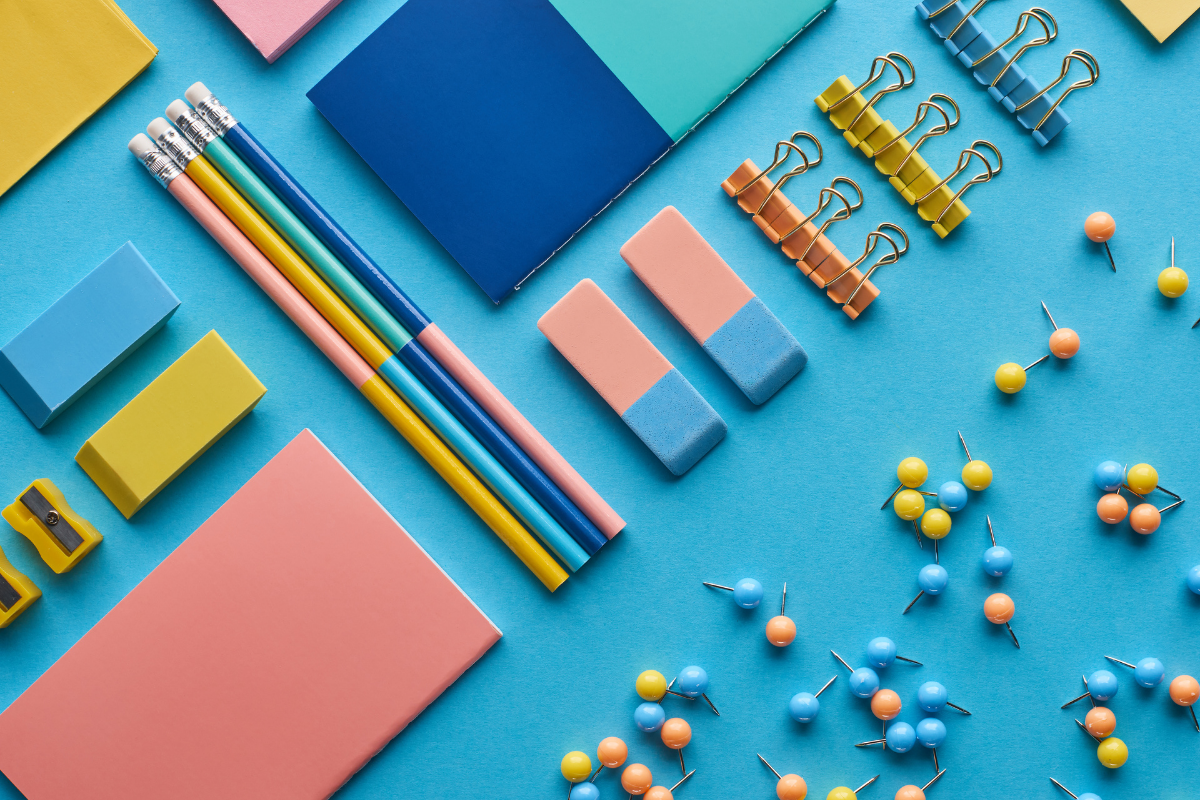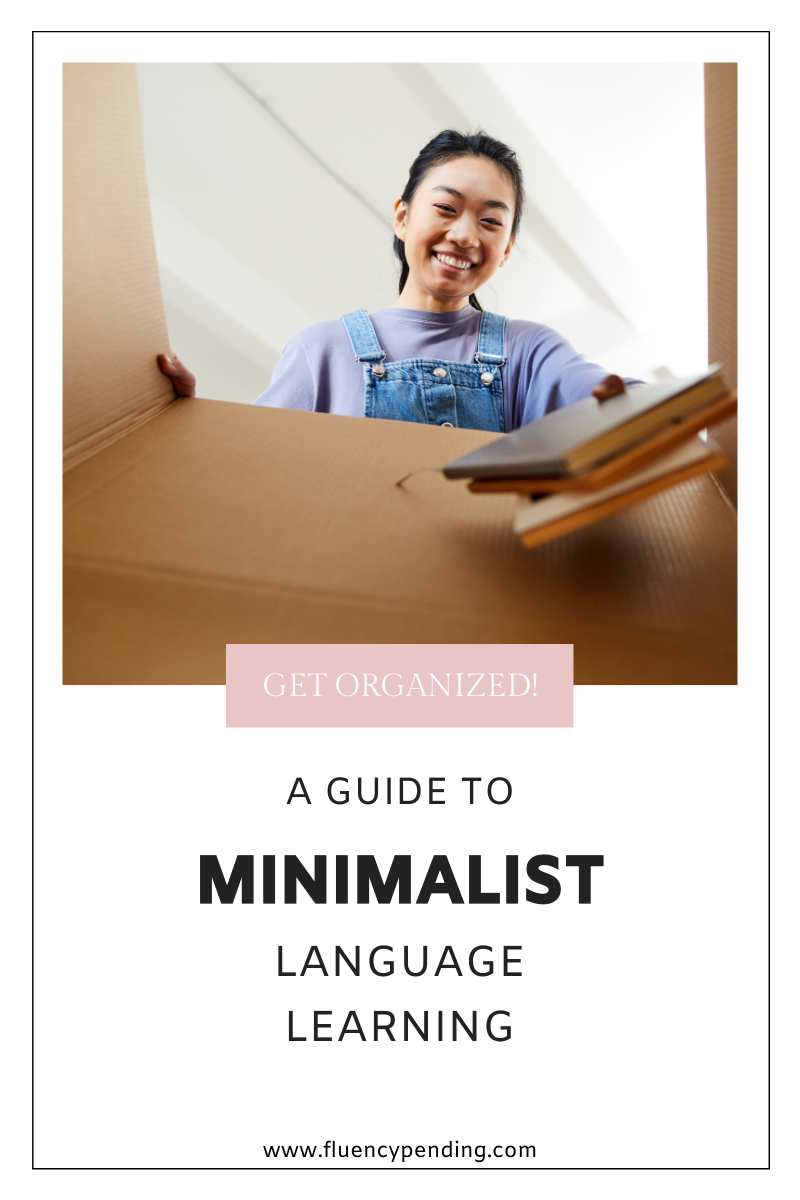
A Guide to Minimalist Language Learning
Please keep in mind that some of the links in this post are affiliate links. In the event of a sale, I will be awarded a small commission (at no extra cost for you).
There are a lot of great things about language learning as a hobby, but all the clutter that tends to go hand in hand with the activity isn’t one of them. We’re talking textbooks, study guides, course material, stationery, flashcards…starting to sound familiar?
I am the first to admit that I am the queen of clutter, but lately I have been trying to embrace a more minimalist approach to language learning.
Why go minimal?
You may think that amassing more and more resources will make it easier to learn your target language, but it can actually overwhelm you and hinder your progress. Not to mention the unnecessary expenses!
Minimalist language learning is not just about getting rid of physical stuff cluttering up your space, but also about reducing the mental load it takes to sort through all that material and deciding what to action.
Here’s how you can adopt minimalist language learning to make your studies more intentional, focused and effective.
Table of Contents
Organizing your language learning resources
Most of us have way more resources than we can reasonably get to. With so much stuff vying for your attention, it can be difficult to sort the wheat from the chaff and start building a curriculum that works for you.
Let’s start with the basics of decluttering. Follow these three simple steps to tame your resources.
- Audit: The first step is to know exactly what you have. Do an audit so you can easily see what you own, what you don’t need and identify any gaps. You can keep a resources page in your language learning journal to keep track of everything and rate their effectiveness.
- Eliminate: Once you know what you have, it’s easier to see what you don’t need. You’ll find some questions below to help you decide what stays and what goes.
- Maintain: Keep it up! Clutter tends to creep back if you don’t have a firm handle on it.
When organizing your resources, ask yourself:
- How does it fit into my language learning schedule and overall goals?
- What problem does it solve?
- Do I already have something else that serves the same purpose?
- Is it suitable for the level I am at right now? If not, will I use it later?
I’ll call these the 4 Qs because we’ll be coming back to it a lot.
Let’s take a look at the types of clutter you’re likely to encounter as a language learner.
Books
This includes textbooks, grammar guides, readers, dictionaries (almost always available online) and so on.
Now, it’s perfectly fine to have a shelf of language learning books if that gives you joy. But if it is taking up too much space or making you feel anxious or overwhelmed, it’s time to cull your collection.
Let go of anything that does not suit your needs and goals (remember your 4 Qs!). You can donate or sell your old books so that someone else can benefit from them.
You can read more about how to choose the right language learning textbook here.
Flashcard decks
When I first started learning Mandarin, I used to write out new vocabulary on cardboard flashcards. As my course load and vocabulary list increased, so did the piles and piles of flashcards.
Nowadays, I organize my flashcards digitally using Anki or Pleco, which really helps to keep paper clutter under control.
If you prefer pen and paper, but want to keep things a little bit more organized, you can try ring-bound flashcards like this colourful hole-punched set or this white ruled set.
Digital resources
Digital language learning resources can be tricky. Since it does not take up any physical space, it can be easy to overlook or just stash in a folder somewhere. But digital clutter can be just as overwhelming as that pile of papers you’ve been meaning to file, especially since we are constantly hooked up to our digital devices.
Freebies
Who doesn’t like a good freebie? A lot of language learning service providers offer free opt-ins or digital gifts to subscribers. Many of these are useful, but just because it is free does not mean it’s suitable for your needs.
Take a good look at all the free digital resources you have saved (or left languishing in your inbox). Delete the ones that do not serve you. It doesn’t cost you anything and you’ll have freed up some mental and hard drive space.
Even good free study material is useless to you unless you take action. Create a dedicated folder on Dropbox or Google Drive for PDFs, ebooks and other digital resources. Don’t let it just sit there though. Add them to your study schedule during your next planning session.
Online courses and monthly subscriptions
It seems that everyone is jumping on the monthly subscription bandwagon these days. Monthly subscription fees may seem like relatively small amounts, but it adds up really quickly.
As a South African, the ZAR to USD exchange rate is not in my favour. This means if it’s costing me money right now, it had better be working hard for me.
I prefer to invest in courses with a one-time fee (like the wonderful Chinese Zero to Hero courses). However, I am willing to splurge on a recurring fee for truly useful resources that fit my study goals, like my ChinesePod quarterly subscription and my iTalki lesson package.
Before you commit to a subscription, run through your 4 Qs to help with the decision making process. You already know that it is costing you money, but what is it giving you in return? If the answer is ‘nothing’, it’s time to cancel that subscription and save your money for something else.
The same process goes for deciding whether to buy an online course with a once-off fee. If you’ve already paid for a course that does not suit your current needs, take it out of your schedule for now, but add it to your ‘to reassess’ list. This can be a folder for downloads, a spreadsheet containing your log-in details or a page in your language journal – whatever works for you.
You already own it and you can’t give it away or sell it, so keep the information handy. Revisit your list once every few months to see if your needs have changed and it can be added back into rotation.
Apps
Raise your hand if you’re constantly struggling to free up space on your mobile and other digital devices. All those language learning apps could be the culprit.
Keep language learning apps in a dedicated folder on your device so you know exactly what you have at your disposal. The great thing about apps is that you can usually uninstall it from your device and redownload it later. So you can declutter your device without feeling too conflicted.
If an app is subscription-based, see the previous section.
The apps you keep should be working hard to earn the privilege of taking up your storage space. Add specific app-focused study slots to your schedule or make a point of using your apps during your dead time (on the train, waiting in a queue, etc.).
Email clutter
I recently lent my mobile to my nephew so he could play a game. He looked down at my screen and said: ‘Why do you have 2,000 unread emails?’.
2,000 unread emails!
It was a shock.
It’s not like I’m a horrible slacker who ignores important emails. These were all inessential messages (to my ‘burner’ personal email) that I’ve allowed to collect in my promotions folder to look at later. Only I never looked at them later, did I?
Four arduous hours later, I had reduced my inbox to zero and unsubscribed from a host of Marketing lists.
A large number of those unopened emails were from various language-related sources, many of which actually contained useful information. I enjoy receiving ChineseClass101.com’s Chinese Word of the Day or my LingQs of the Day. It was just that my inbox was so drowned in other clutter that it was very difficult to make the most of these useful resources.
Tips for taming your inbox
Unsubscribe – Unsubscribe to any emails you haven’t opened in a month.
Set up rules – Automatically move emails to a specific folder, such as ‘language learning’, so you can view it all in one place. How to do this will depend on your email service provider, but there are plenty of tutorials online.
Take action – Action emails immediately following the SAD (sort, address, delete) method. Sort useful material by adding it to your dedicated Dropbox folder to be added to your schedule, address anything that requires a reply or action, and delete anything spammy or read.
Get rid of email notifications from language learning apps – Do you really need the Duolingo owl guilting you on both email and your mobile? If you are already receiving notifications from the app itself, you don’t need to be reminded via email as well.
Time management – Decide how much time you can commit to actioning emails per day and keep only the useful email subscriptions that can be dealt with within that time frame.
There are email management products like Sanebox that can help you with email management. While useful, most of these are paid subscription services. You already know how I feel about those, so I would recommend you look into this only if all other methods have failed and you are in dire need of an intervention. Or you’re just flush with cash and can afford it…
Notebooks and printables
I love collecting pretty notebooks, but lately I have resisted the siren call of Typo.
While I still like to keep notebooks for specific purposes (like Goldlists), I now prefer to collate everything into a single digital language learning notebook.
If you are curious about how to set up your own language learning journal, you can check out these articles:
You can also import language learning printables into your note taking app and use a stylus to complete them. If you do not have a tablet and stylus, keep printables neat and organized in files.
Organizing your study space
Minimalist language learning is also about keeping your study space as comfortable and clutter-free as possible.
Besides notebooks, I am also saying bye bye to:
- Stationery – broken or dry highlighters and pens, that eraser that leaves black marks on the page…it’s all got to go!
- Drooping plants – sorry I killed you!
- Extra water bottles – why do I have 4?
- Dog toys – my two dogs like invading my study. I got them a bin for all their soggy soft toys.
- Desk trinkets – no more buying pop figurines and collectibles. I am only keeping the ones that make my soul happy.
- Extra computer peripherals – keyboards, headphones, etc.
- CDS and DVDs – my computer does not even have a CD drive! You can find hardware drivers online.
- Other people’s stuff – it’s your space, not a dumping ground for others’ overflow.
- Cables of unknown origin – keep them in a box in the garage for a while if you are worried it is something important.
Maintain to keep sane
Now that you’ve cleared the clutter, maintain your sanity by being discerning in your shopping habits.
Beware the sales – Don’t get me wrong, I love a good bargain. I buy most of my language learning resources on sale, but lately I have become much more intentional with my purchases. I have a list of books or courses I would like to buy and keep an eye out for any specials throughout the year.
Having a list to stick to makes you less likely to buy something just because it’s on sale. Sales are often designed to create a false sense of urgency. The truth is that the special offer will likely come around again. If you truly regret not jumping on that deal when you had the chance, you’ll know to have your credit card at the ready the next time there’s a sale.
Impulse buys – Sleep on it. If you still feel you desperately need to buy it in the morning, then it’s all yours.
Buying above or below your level – This is a tricky one and may depend on your preference, but I try to assess my needs once I reach a certain level to avoid spending money on something I may never use.
Travel buys – I am very guilty of this one. Buying something just because you can’t find it in your country or area is tempting, but remember your 4 Qs!
Time management (again) – How much time can you realistically devote to your new resource? How will it fit into your study schedule? You don’t need another thing that makes you feel guilty or that you are somehow failing at keeping up (you’re not).
Minimalist language learning: the takeaway
Minimalist language learning is not about giving away everything you own, but rather making sure everything you have serves a purpose (even if it’s just making you smile) and contributes positively to your language learning journey.
Get rid of anything that:
- Makes you feel guilty
- Costs you money without giving anything in return
- Clutters your space and your mind
- Does not align with your goals
Do you practice minimalist language learning? What are the things you got rid of to simplify your study routine? Let me know in the comments!







